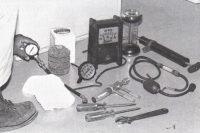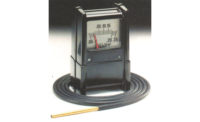Now, Bob’s company has promoted him to help train a new employee, right out of a school specializing in HVAC, just like Bob was. Bob is now Tim’s Btu Buddy. Tim is anxious to travel with Bob. Tim realizes that he is right out of school, with the theory and lab work that he accomplished in school, but still needs help. He knows that he worked with many of the components of the systems in the school, under ideal conditions with good light and air conditioning. Now it is into the field, sometimes under the house with poor lighting, or out on the rooftop in the sun, where the real action is. He is naturally and normally reluctant, but he has Bob to help guide him.
Bob and Tim were on their way to a no heat call. It was an oil heat application and Tim was anxious to work on an oil system. He had not seen an actual oil heat installation, only in the school lab. Those are great, but not like the real thing at a customer’s house.
When they arrived, the homeowner met them at the door and explained what he knew. He said, “I could hear the heat come on and after about a minute or so, it would go off. Then I went to the basement and pushed the little reset button on the side of the burner and it would start again and run for about two minutes. It sounded funny, not like normal.”
Bob asked, “How many times did you push the red button?”
The homeowner said, “Probably 10 or more times.”
Bob said, “You should never push a reset button more than three times without finding out what the cause is. If the oil pump is pumping oil, it will add oil to the combustion chamber that is unburned. If it fires after several tries, you will have a large fire in the combustion chamber that will be unsafe. About the only thing you can do if this happens is to stop the fuel and air from getting to the fire and let it burn itself out. The furnace will shake and sound like it is going to come apart as it burns the fuel out of the combustion chamber. The fan should come on and help dissipate the heat; if not, the furnace may become really hot and become warped. You just about can’t put the fire out, because it is contained inside the metal furnace. If you try to open the inspection door, fire will shoot out.”
Bob and Tim then went to the basement to look the job over. Bob told Tim to remove the burner from the furnace for a look inside.
When Tim had the burner on the floor, Bob told Tim to take the flashlight and look inside the combustion chamber and let him know what he saw.
Tim looked and said, “There is a lot of oil inside the chamber. What is that all about?”
Bob said, “Every time the reset button was pressed, the oil pump pushed oil into the chamber but the burner didn’t fire, so it just accumulated. Take a rag and wipe all the oil you can out of the chamber and we will see why the burner is not firing.”
Tim got the combustion chamber cleaned out and they started examining the burner. Tim said, “The cad cell has a coat of soot on it. The fire must have been burning really dirty. The inside of the combustion chamber has a lot of soot also.”
Bob said, “Let’s change the oil nozzle and the filter and set the electrodes. Be sure to use this special nozzle wrench (Figure 1) to remove the nozzle.”
Tim said, “My instructor was big on using a nozzle wrench. It seemed to me like it was just another tool to carry in the box. Why wouldn’t two adjustable wrenches work as well?”
Bob explained, “You need the nozzle wrench to reach inside the electrodes to get at the nozzle. If you use adjustable wrenches, you take a chance of them slipping. The nozzle is a delicate device and easily damaged. Almost every time someone goes to the trouble of developing a specialty wrench, it is worth it.”
Tim started to change the nozzle and said, “There are several nozzles lying next to the furnace and there are three different sizes. Which one should I use?”
Bob responded, “Look on the nameplate of the furnace. It will tell you what you want to know.”
Tim said, “The nameplate calls for a .75 gph (gallons per hour) nozzle, yet there is a .65, a .75, and a .85 nozzle among the nozzles lying here.”
Bob said, “This is a new job for us and we don’t know what has been done in the past. Let’s go with the manufacturer’s recommendation of .75 gph. I always like to believe that they are the ones that know what is correct. Somebody may have changed nozzles and just used what was in their supply of nozzles and experimented with the oil pressure to get the desired fire. In fact, we don’t know why this burner is not firing so we should just give this burner a good tune up from beginning to end and then try to fire it.”
They performed the following:
1. Changed the nozzle.
2. Changed the fuel filter.
3. Set the electrodes.
4. Changed the cad cell.
5. Checked the tank for fuel level and water content.
6. Fastened gauges on the pump (Figure 2).
7. Examined inside the flue for soot and found it clean.
Then they started the unit and it fired right up.
Bob said, “Get the draft gauge and the combustion analyzer and let’s make sure that it is operating efficiently.”
When they completed the tune up and ran the furnace, all worked well. They then explained to the homeowner what they had done and he was really pleased. He asked, “Does this tune up need to be done often?”
Bob said, “The oil burner is a great source of heat. It is not as expensive as most of the others, but it must be fine tuned to get the efficiency that you really need to be inexpensive. The burner and the pump system are a precision and delicate piece of equipment. The oil storage system has a tendency to collect dirt and must be maintained. For example, you have an over ground tank. Every day it warms up and the oil and air inside swells a little, then at night it shrinks and draws in night air, with moisture in it. This moisture condenses in the tank and creates water. The inside of the tank is common steel and it forms some rust and makes the oil dirty. The filters are great about filtering it out, but some probably slips through over time. The tune up takes care of all of these variables and keeps the burner operating at peak efficiency. Gas, electric, and heat pump systems do not have these issues.”
The customer said, “I think you are right. I will start having a yearly tune up for this system.”
As they were riding away, Tim said, “I want you to explain all of the things that we did and why. I heard it all in school, but it seems to mean more when we are dealing with a customer. All I did in school is make these adjustments because we were required. It gets down to dollars and cents and explaining it to a customer. I could tell that the customer listened to every word you said and he knew that you were telling him the facts, not just selling him service.”
Bob said, “If you have some time after work today, we will sit down and talk about it.”
(Continued next month.)
Publication date: 11/19/2012












